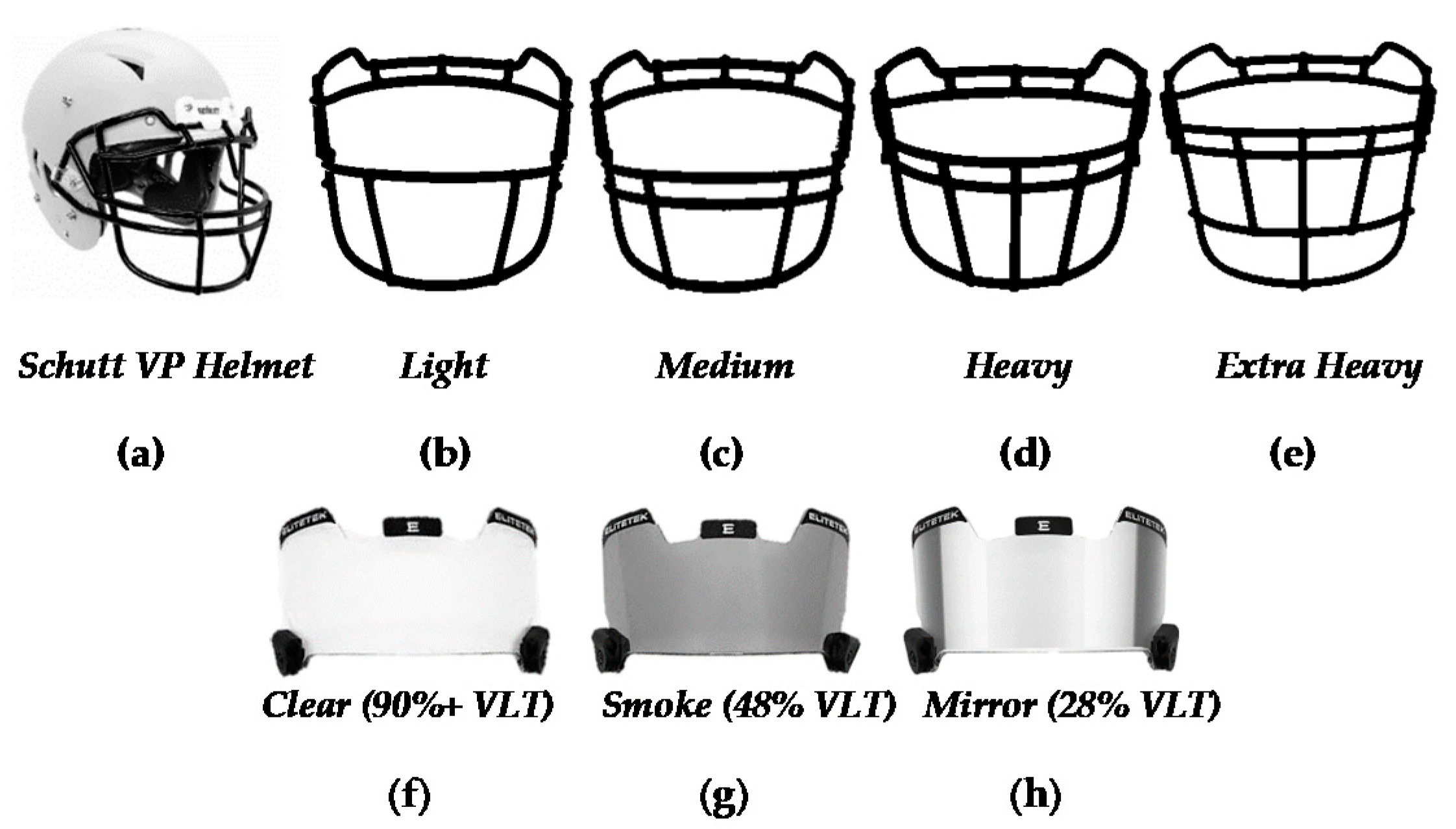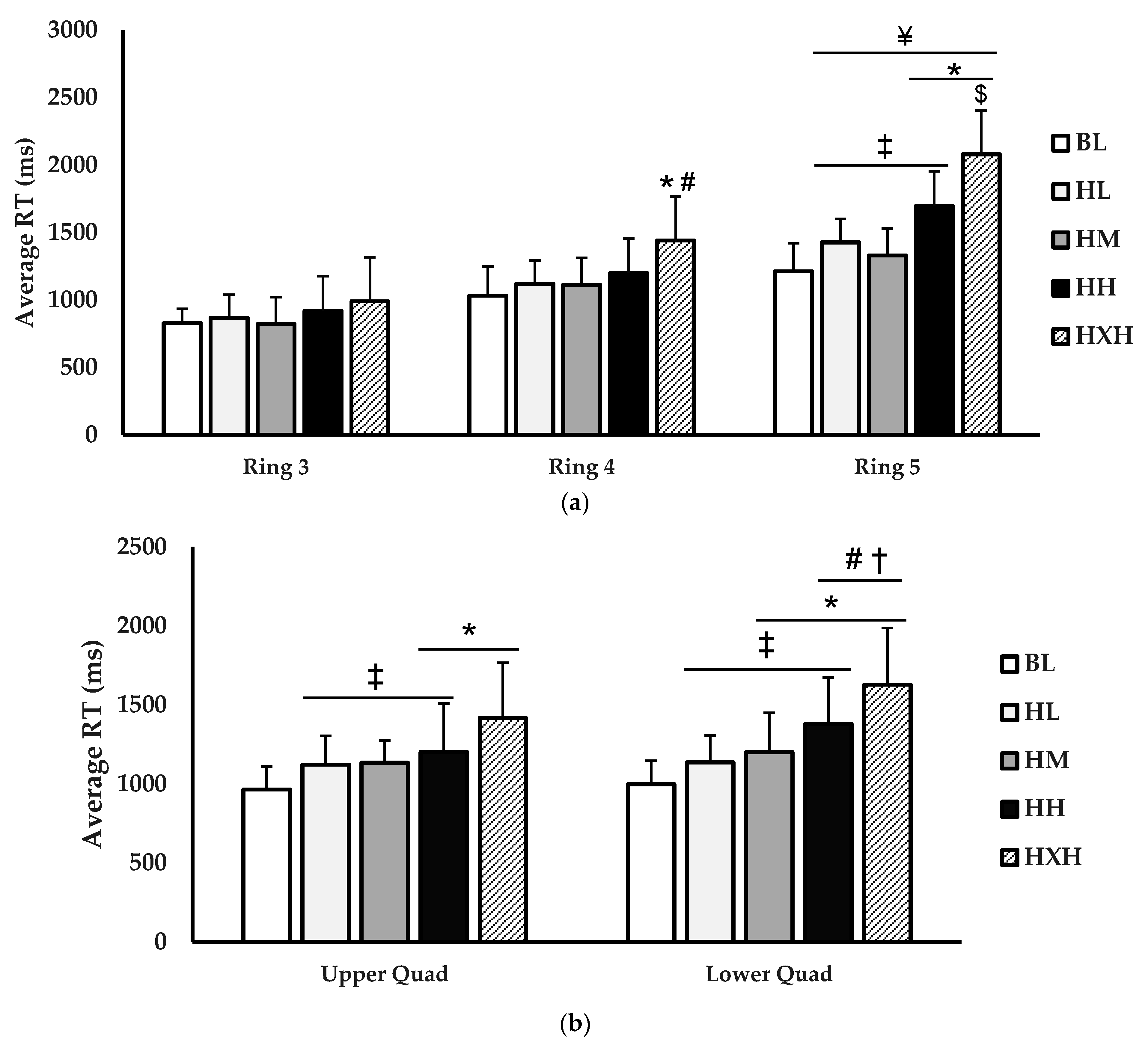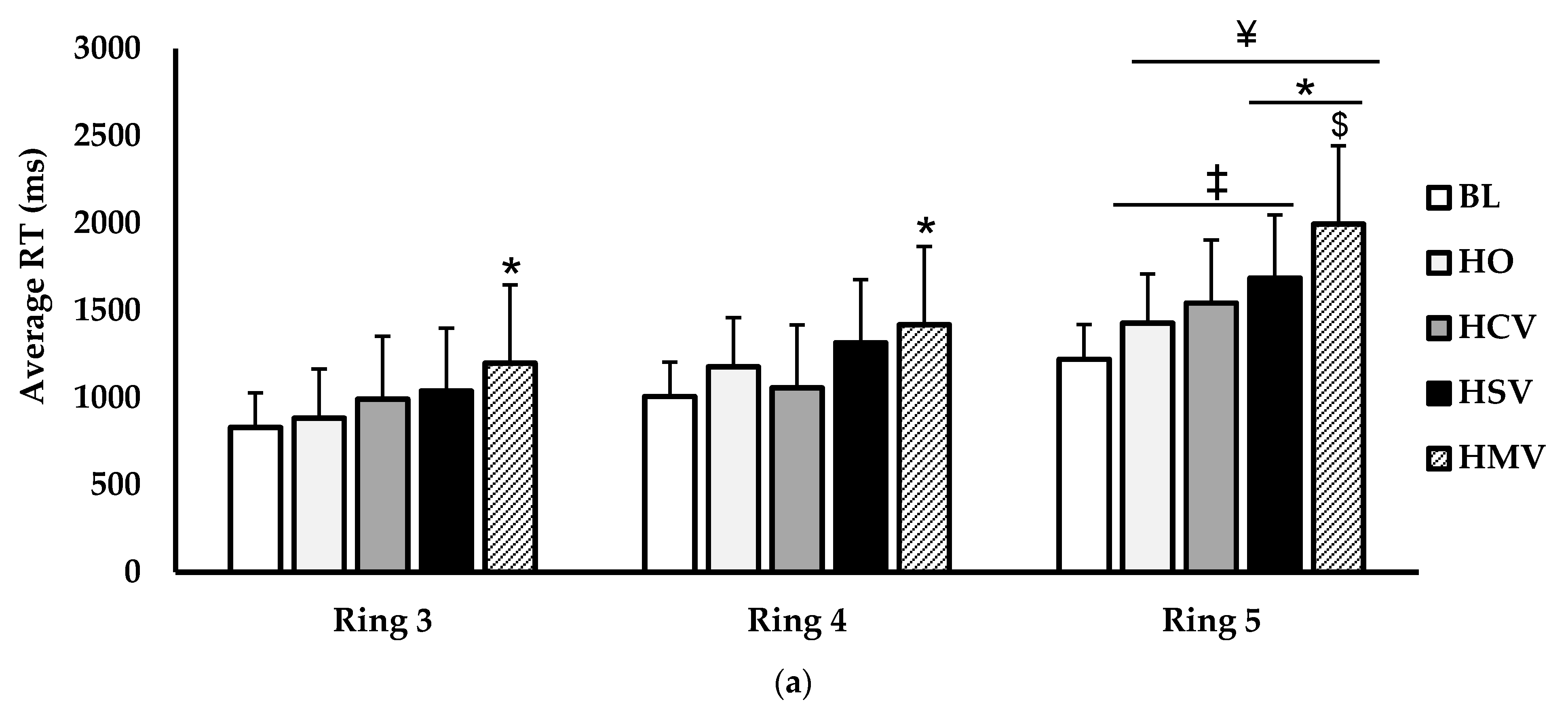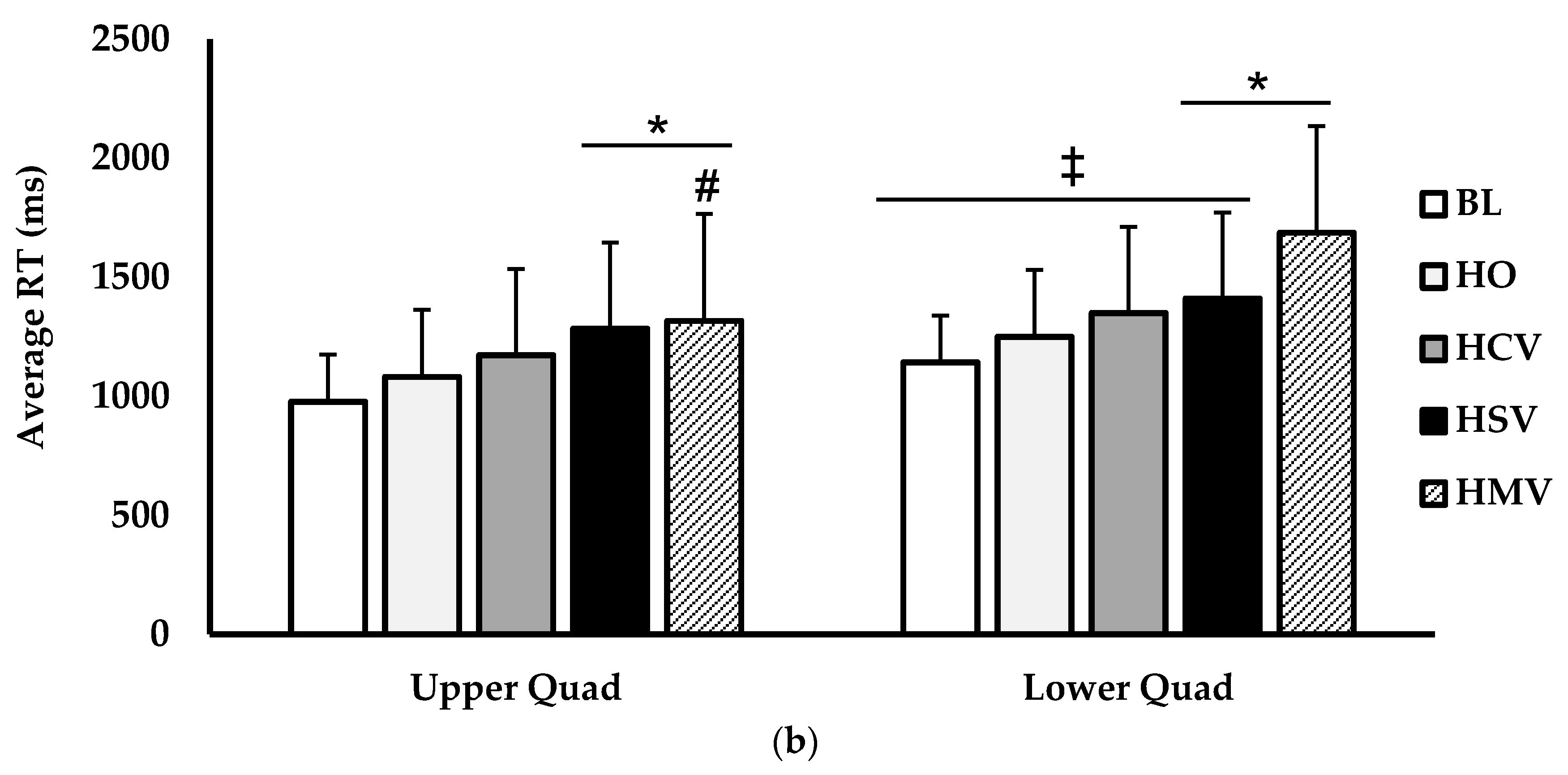Protective Football Headgear and Peripheral Visuomotor Ability in NCAA Football Athletes: The Role of Facemasks and Visors
Abstract
1. Introduction
2. Materials and Methods
2.1. Participants
2.2. Experiment 1: Facemask Reinforcement
2.3. Experiment 2: Visor Tint
2.4. Peripheral Visuomotor Testing
2.5. Statistical Analysis
3. Results
3.1. Experiment 1: Facemask Reinforcement
3.2. Experiment 2: Visor Tint
4. Discussion
5. Conclusions
Author Contributions
Funding
Institutional Review Board Statement
Informed Consent Statement
Data Availability Statement
Conflicts of Interest
References
- Levy, M.L.; Ozgur, B.M.; Berry, C.; Aryan, H.E.; Apuzzo, M.L.J. Birth and Evolution of the Football Helmet. Neurosurgery 2004, 55, 656–662. [Google Scholar] [CrossRef]
- Levy, M.L.; Ozgur, B.M.; Berry, C.; Aryan, H.E.; Apuzzo, M.L. Analysis and Evolution of Head Injury in Football. Neurosurgery 2004, 55, 649–655. [Google Scholar] [CrossRef]
- Gelberg, J.N. The Lethal Weapon: How the Plastic Football Helmet Transformed the Game of Football, 1939–1994. Bull. Sci. Technol. Soc. 1995, 15, 302–309. [Google Scholar] [CrossRef]
- Mishra, A.; Verma, A.K. Sports related ocular injuries. Med. J. Armed Forces India 2012, 68, 260–266. [Google Scholar] [CrossRef] [PubMed]
- Schneider, R.C.; Antine, B.E. Visual-Field Impairment Related to Football Headgear and Face Guards. JAMA 1965, 192, 616–618. [Google Scholar] [CrossRef] [PubMed]
- Miller, R.A.; Rogers, R.R.; Williams, T.D.; Marshall, M.R.; Moody, J.R.; Hensarling, R.W.; Ballmann, C.G. Effects of Protective American Football Headgear on Peripheral Vision Reaction Time and Visual Target Detection in Division I NCAA Football Players. Sports 2019, 7, 213. [Google Scholar] [CrossRef] [PubMed]
- Kung, S.M.; Suksreephaisan, T.K.; Perry, B.G.; Palmer, B.R.; Page, R.A. The Effects of Anticipation and Visual and Sensory Performance on Concussion Risk in Sport: A Review. Sports Med. Open 2020, 6, 1–14. [Google Scholar] [CrossRef] [PubMed]
- Dompier, T.P.; Kerr, Z.Y.; Marshall, S.W.; Hainline, B.; Snook, E.M.; Hayden, R.; Simon, J.E. Incidence of Concussion During Practice and Games in Youth, High School, and Collegiate American Football Players. JAMA Pediatr. 2015, 169, 659–665. [Google Scholar] [CrossRef]
- Crisco, J.J.; Fiore, R.; Beckwith, J.G.; Chu, J.J.; Brolinson, P.G.; Duma, S.; McAllister, T.W.; Duhaime, A.C.; Greenwald, R.M. Frequency and Location of Head Impact Exposures in Individual Collegiate Football Players. J. Athl. Train. 2010, 45, 549–559. [Google Scholar] [CrossRef]
- Rowson, S.; Duma, S.M.; Greenwald, R.M.; Beckwith, J.G.; Chu, J.J.; Guskiewicz, K.M.; Mihalik, J.P.; Crisco, J.J.; Wilcox, B.J.; McAllister, T.W.; et al. Can helmet design reduce the risk of concussion in football? J. Neurosurg. 2014, 120, 919–922. [Google Scholar] [CrossRef] [PubMed]
- McGuine, A.T.; Brooks, A.; Hetzel, S.; Rasmussen, J.; McCrea, M. The Association of the Type of Football Helmet and Mouth Guard with the Incidence of Sport Related Concussion in High School Football Players. Orthop. J. Sports Med. 2013, 1, 2325967113S00027. [Google Scholar] [CrossRef]
- Collins, M.; Lovell, M.R.; Iverson, G.L.; Ide, T.; Maroon, J. Examining Concussion Rates and Return to Play in High School Football Players Wearing Newer Helmet Technology: A Three-Year Prospective Cohort Study. Neurosurgery 2006, 58, 275–286. [Google Scholar] [CrossRef] [PubMed]
- Daneshvar, D.H.; Baugh, C.M.; Nowinski, C.J.; McKee, A.C.; Stern, R.A.; Cantu, R.C. Helmets and Mouth Guards: The Role of Personal Equipment in Preventing Sport-Related Concussions. Clin. Sports Med. 2011, 30, 145–163. [Google Scholar] [CrossRef]
- Shelly, Z.; Stewart, E.; Fonville, T.; Burch, R.F.V.; Chander, H.; Strawderman, L.; May, D.; Smith, J.; Carruth, D.; Bichey, C. Helmet Prototype Response Time Assessment using NCAA Division 1 Collegiate Football Athletes. Int. J. Kinesiol. Sports Sci. 2019, 7, 53–65. [Google Scholar] [CrossRef]
- Kramer, M.R.; Teel, E.F.; Wasserman, E.B.; Mihalik, J.P. Effect of Protective Helmets on Vision and Sensory Performance in Healthy Men. Athletic Training and Sports Health Care, Sports Med. Open 2020, 6. [Google Scholar] [CrossRef]
- NCAA. 2020 NCAA Football Rules and Interpretations; The National Collegiate Athletic Association: Indianapolis, IN, USA, 2020. [Google Scholar]
- Zhang, H.; Jiang, X. The application of protective devices in sports-related eye injuries. In Ocular Emergency; J.B. Metzler: Berlin, Germany, 2020; pp. 107–119. [Google Scholar]
- Clark, J.F.; Graman, P.; Ellis, J.K.; Mangine, R.E.; Rauch, J.T.; Bixenmann, B.; Hasselfeld, K.A.; Divine, J.G.; Colosimo, A.J.; Myer, G.D. An exploratory study of the potential effects of vision training on concussion incidence in football. Optom. Vis. Perform. 2015, 3, 116–125. [Google Scholar]
- Holliday, A.E.; Wells, M.A.; Rogers, R.R.; Pederson, J.A.; Williams, T.; Ballmann, C.G. Effects of Caffeinated and Non-Caffeinated Gum on Premotor, Motor, and Overall Reaction Time. Exerc. Sci. Kinesiol. 2020, 1, 7. [Google Scholar]
- Wells, A.J.; Hoffman, J.R.; Beyer, K.S.; Jajtner, A.R.; Gonzalez, A.M.; Townsend, J.R.; Mangine, G.T.; Robinson IV, E.H.; McCormack, W.P.; Fragala, M.S. Reliability of the dynavision™ d2 for assessing reaction time performance. J. Sports Sci. Med. 2014, 13, 145. [Google Scholar]
- Vesia, M.; Esposito, J.; Prime, S.L.; Klavora, P. Correlations of Selected Psychomotor and Visuomotor Tests with Initial Dynavision Performance. Percept. Mot. Ski. 2008, 107, 14–20. [Google Scholar] [CrossRef]
- Ramirez Gomez, A.; Gellersen, H. SuperVision: Playing with gaze aversion and peripheral vision. In Proceedings of the 2019 CHI Conference on Human Factors in Computing Systems, Glasgow, UK, 4–9 May 2019; pp. 1–12. [Google Scholar]
- Lungaro, P.; Sjoberg, R.; Valero, A.J.F.; Mittal, A.; Tollmar, K. Gaze-Aware Streaming Solutions for the Next Generation of Mobile VR Experiences. IEEE Trans. Vis. Comput. Graph. 2018, 24, 1535–1544. [Google Scholar] [CrossRef]
- Ruedl, G.; Herzog, S.; Schöpf, S.; Anewanter, P.; Geiger, A.; Burtscher, M.; Kopp, M. Do Ski Helmets Affect Reaction Time to Peripheral Stimuli? Wilderness Environ. Med. 2011, 22, 148–150. [Google Scholar] [CrossRef] [PubMed]
- Hoshizaki, T.B.; Brien, S.E. The Science and Design of Head Protection in Sport. Neurosurgery 2004, 55, 956–967. [Google Scholar] [CrossRef] [PubMed]
- Dowler, P.M.; Pearsall, D.J.; Stapley, P.J. Effects of ice hockey facial protectors on the response time and kinematics in goal-directed tasks. Proc. Inst. Mech. Eng. Part. P. J. Sports Eng. Technol. 2009, 223, 99–108. [Google Scholar] [CrossRef]
- González-Alvarez, C.; Subramanian, A.; Pardhan, S. Reaching and grasping with restricted peripheral vision. Ophthalmic Physiol. Opt. 2007, 27, 265–274. [Google Scholar] [CrossRef] [PubMed]
- Gao, Y.; Chen, L.; Yang, S.-N.; Wang, H.; Yao, J.; Dai, Q.; Chang, S. Contributions of Visuo-oculomotor Abilities to Interceptive Skills in Sports. Optom. Vis. Sci. 2015, 92, 679–689. [Google Scholar] [CrossRef] [PubMed]
- Bass, T. Football Skills & Drills; Human Kinetics: Champaign, IL, USA, 2012. [Google Scholar]
- XENITH. What Facemask Should I Buy for My Helmet? Available online: https://www.xenith.com/blogs/the-huddle/facemask-blog (accessed on 16 January 2021).
- Riddell. Riddell 2021 Catalog. Available online: http://content.riddell.com/team-catalog/ (accessed on 16 January 2021).
- Bradley, J.; Honkamp, N.J.; Jost, P.; West, R.; Norwig, J.; Kaplan, L.D. Incidence and variance of knee injuries in elite college football players. Am. J. Orthop. 2008, 37, 310–314. [Google Scholar]
- Rothenberg, P.; Grau, L.; Kaplan, L.; Baraga, M.G. Knee Injuries in American Football: An Epidemiological Review. Am. J. Orthop. 2016, 45, 368–373. [Google Scholar]
- Baker, H.P.; Varelas, A.; Shi, K.; Terry, M.A.; Tjong, V.K. The NFL’s Chop-Block Rule Change: Does It Prevent Knee Injuries in Defensive Players? Orthop. J. Sports Med. 2018, 6, 2325967118768446. [Google Scholar] [CrossRef] [PubMed]
- Schmidt, J.D.; Phan, T.T.; Courson, R.W.; Reifsteck, F.; Merritt, E.D.; Brown, C.N. The Influence of Heavier Football Helmet Faceguards on Head Impact Location and Severity. Clin. J. Sport Med. 2018, 28, 106–110. [Google Scholar] [CrossRef] [PubMed]
- Wolf, E.; McFarland, R.A.; Zigler, M. Influence of tinted windshield glass on five visual functions. Highway Research Board Bulletin 1960, 255, 30–46. [Google Scholar]
- Lai, H.-H.; Huang, H. Evaluation of visibility of tinted helmet visors for motorcycle riders. Int. J. Ind. Ergon. 2008, 38, 953–958. [Google Scholar] [CrossRef]
- Pinkus, A.R.; Task, H.L.; Hausmann, M.A.; Barbato, M.H.; Goodyear, C.D. Dynamic Visual Acuity Assessment through Visors; Task Consulting: Dayton, OH, USA, 2004. [Google Scholar]
- Pollack, J.D. Reaction time to different wavelengths at various luminances. Percept. Psychophys. 1968, 3, 17–24. [Google Scholar] [CrossRef]
- Bell, A.H.; Meredith, M.A.; Van Opstal, A.J.; Munoz, D.P. Stimulus intensity modifies saccadic reaction time and visual response latency in the superior colliculus. Exp. Brain Res. 2006, 174, 53–59. [Google Scholar] [CrossRef] [PubMed]
- Burns, N.R. Effects of car window tinting on visual performance: A comparison of elderly and young drivers. Ergonomics 1999, 42, 428–443. [Google Scholar] [CrossRef]
- Zimmerman, A.B.; Good, G.W.; McLaughlin, W.R.; Katz, S.E. Intercollegiate usage schedule and the impact resistance of used football helmet faceshields. Optom.J. Am. Optom. Assoc. 2011, 82, 274–283. [Google Scholar] [CrossRef] [PubMed]
- Norris, R.A. Lateral Vision Football Helmet. U.S. Patent US8528118B2, 17 November 2011. [Google Scholar]







Publisher’s Note: MDPI stays neutral with regard to jurisdictional claims in published maps and institutional affiliations. |
© 2021 by the authors. Licensee MDPI, Basel, Switzerland. This article is an open access article distributed under the terms and conditions of the Creative Commons Attribution (CC BY) license (https://creativecommons.org/licenses/by/4.0/).
Share and Cite
Ballmann, C.G.; Covington, A.C.; Miller, R.A.; Rogers, R.R. Protective Football Headgear and Peripheral Visuomotor Ability in NCAA Football Athletes: The Role of Facemasks and Visors. J. Funct. Morphol. Kinesiol. 2021, 6, 34. https://doi.org/10.3390/jfmk6020034
Ballmann CG, Covington AC, Miller RA, Rogers RR. Protective Football Headgear and Peripheral Visuomotor Ability in NCAA Football Athletes: The Role of Facemasks and Visors. Journal of Functional Morphology and Kinesiology. 2021; 6(2):34. https://doi.org/10.3390/jfmk6020034
Chicago/Turabian StyleBallmann, Christopher G., Anna C. Covington, Rachel A. Miller, and Rebecca R. Rogers. 2021. "Protective Football Headgear and Peripheral Visuomotor Ability in NCAA Football Athletes: The Role of Facemasks and Visors" Journal of Functional Morphology and Kinesiology 6, no. 2: 34. https://doi.org/10.3390/jfmk6020034
APA StyleBallmann, C. G., Covington, A. C., Miller, R. A., & Rogers, R. R. (2021). Protective Football Headgear and Peripheral Visuomotor Ability in NCAA Football Athletes: The Role of Facemasks and Visors. Journal of Functional Morphology and Kinesiology, 6(2), 34. https://doi.org/10.3390/jfmk6020034






